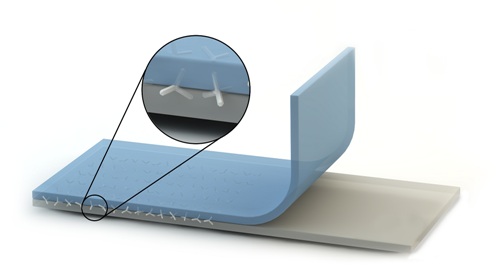Researchers at the Kiel University have developed a new technology that can join Teflon and silicone. Passive nano-scaled crystal linkers are employed as staples to join these two “un-joinable materials”.
 The two polymer layers are stapled from the inside using nano crystals made of zink oxide. Conceptional drawing. Copyright: CAU, Image: Jan Strüben
The two polymer layers are stapled from the inside using nano crystals made of zink oxide. Conceptional drawing. Copyright: CAU, Image: Jan Strüben
Teflon, commonly used for frying pans, is a non-sticky material. Silicone is a synthetic material that demonstrates very low “stickiness” or adhesion. It is a low surface energy polymer. These two materials are considered to be un-joinable due to their properties.
Professor Rainer Adelung, the leader of the functional nano materials group at Kiel University’s Institute of Materials Science, stated that if the nano staples were able to stick Teflon to silicone, then they could also join other kinds of plastic materials. This technology does not require expensive material or equipment. The staples are shaped like tetrapods and are made of nano scaled zinc oxide crystals. Large tetrapods are used in coastal protection as they can interlock to form strong bonds.
The tetrapod-shaped zinc oxide crystals are sprinkled in an even manner onto a layer of Teflon that has been heated. Over this material, a layer of silicone is poured, and the combination is heated for around an hour to a temperature of 100°C. During the heating process, the nano tetrapods pierce, sink and get anchored into both the materials. When a tetrapod is attempted to be pulled out by one arm it will make the other arms to get anchored deeper.
This technology holds huge potential for medical applications where silicone has to be stuck on to other materials. Biocompatible materials are required for medical applications.
The research involved research groups in biomechanics, chemistry and material science. The study has been published in the journal Advanced Materials.